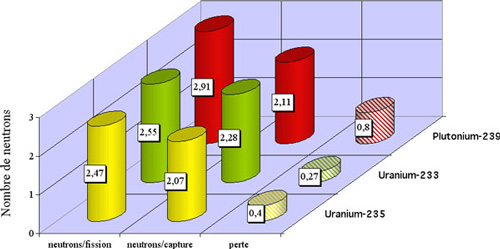Uranium 235 and 233, plutonium 239
The few fissile nuclei found in nature belong to heavy atoms, with very high atomic masses. On the map of observed nuclei, they are located near uranium at the upper end of the stability line. The most notable are uranium 233, uranium 235, plutonium 239 and plutonium 241. Less known are protactinium 230, neptunium 235 and americium 242. Most of them have very long lifetimes of several thousands or millions of years with a radioactive alpha decay

Comparison of the 3 main fissile nuclei
Comparison of secondary neutrons and neutrons available for a new fission, after the fission of uranium 235, uranium 233 and plutonium 239 by the absorption of a slow neutron. Of the three nuclei, plutonium 239 produces the largest number of secondary neutrons. As not all neutron absorptions lead to nuclear fission, the important figure is how many neutrons are available to induce fission. When this number is equal to 1 a chain reaction can be maintained, and at 2 the fuel can maintain itself (breeding).
© IN2P3
The size of fissile nuclei approaches the maximum allowed for a nucleus. All are unstable, but most of them have very long lifetimes of several thousands or millions of years with a radioactive alpha decay. More than their instability, the remarkable feature of these nuclei is their fragility when they capture an extra neutron.
They all have odd numbers of neutrons, with the lightest possessing 91 protons and 129 neutrons. The number of protons is even for the 4 main fissile nuclei (uranium 92 and plutonium 94) and odd for the other three.
These 7 fissile isotopes belong to the class of chemicals known as the ‘actinides‘.
Three of these have a practical use: uranium 233, uranium 235 and plutonium 239. Uranium 235 has the longest half-life of the three, with a period of 0.7 billion years. A rare isotopes today, it was 86 times more abundant at the time of the Earth’s formation. Plutonium 239 lives for only 24,000 years, but large quantities of it are regularly produced in uranium reactors. If thorium-based reactors become a reality, then the same will one day be true of uranium 233, whose half-life is 160,000 years.
Other articles on the subject « Nuclear Fission »
200 millions electronvolts !
A huge amount of energy at the atomic scale The fission of a uranium or plutonium nucleus liberat[...]
Chain Reaction
From one single fission to fissions on a massive scale Nuclear fission emits a lot of energy on t[...]
Fission fragment
Chronicle of the life of a fission fragment … The fission of a nucleus into two fragments i[...]
Fission products
The ashes of nuclear fission Fission products are the remains of a heavy uranium or plutonium nuc[...]
Plutonium-239 formation
Transforming a fertile nucleus into a fissile nucleus Uranium-238 accounts for more than 95% of t[...]
Short-lived Fission Products
Most fission products vanish rather rapidly The vast majority of the radioactive fission products[...]
Long-lived Fission Products
A handful of tough but little radioactive isotopes … The more a nucleus is long-lived, the [...]
Actinides
A class of very heavy radioactive nuclei Alongside the fission products found in the core of nucl[...]
Plutonium Isotopes
Plutonium-239 but also 238, 240, 241, 242 … Plutonium isotopes are produced by neutron capt[...]
Minor Actinides
Neptunium, americium and curium Minor actinides constitute a very small minority of high activity[...]